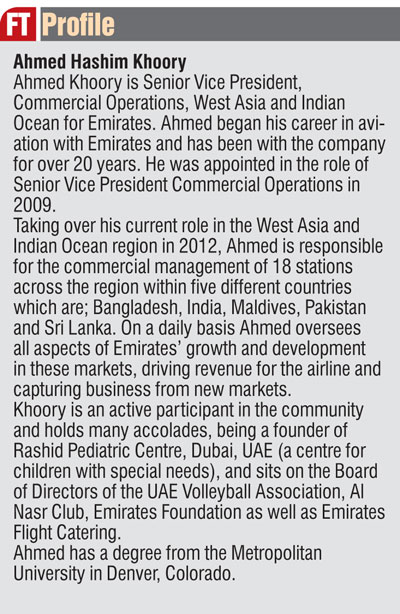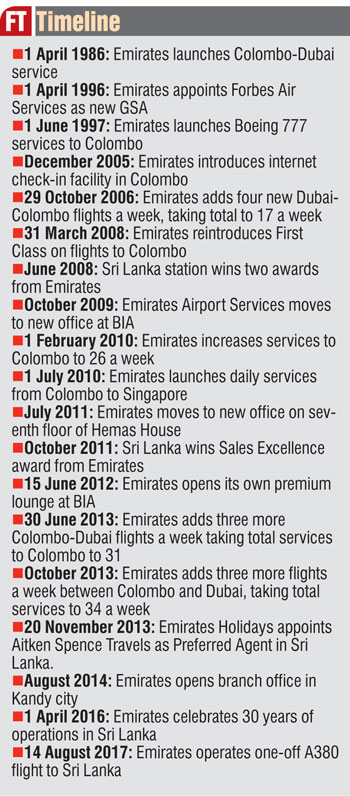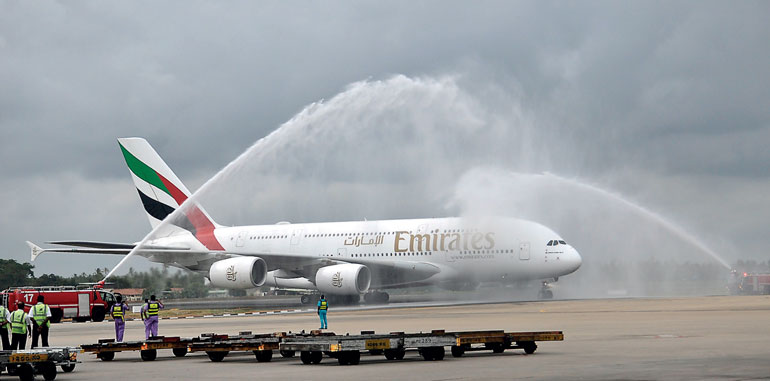Saturday Apr 20, 2024
Saturday Apr 20, 2024
Thursday, 21 September 2017 10:24 - - {{hitsCtrl.values.hits}}

Sri Lanka is an important market for Emirates and it is constantly exploring opportunities to facilitate growth, travel and leisure as well as trade in the country, asserted Ahmed Khoory, Senior Vice President, Commercial Operations, West Asia and Indian Ocean for Emirates.
In a wide-ranging interview with Daily FT, he said Emirates was proud of the fact that it has maintained continuous services to the country throughout the past three decades. “Emirates has recorded solid year-on-year growth in Sri Lanka over the years, carrying over four million passengers on the route in the last three decades,” he added.
Commenting on the recent one-off A380 flight to Sri Lanka, he said it was an important development that reflected the strong relationship with the market and Emirates’ commitment to Sri Lanka. “It means that when demand for the destination grows, as it definitely will, to the point that a scheduled A380 flight is feasible, Emirates will be ready to operate on that basis. The one-off A380 was very well received in the market and the feedback was overwhelmingly positive,” he added.
Khoory is a strong advocate for an ‘open skies’ policy, pointing out that any country’s promise can be unlocked through its benefits and in the broader context benefit the economy and enable mobility.

Touching on the Emirates Group’s financial and operational performance over the past few years in the backdrop of industry challenges, he said it was testament to the success of its business models and strategies, as well as the commitment and talent of its employees across six continents.
“In the past three decades since it launched operations, Emirates has grown into the world’s largest airline, pioneered numerous innovations, won hundreds of awards and become a benchmark for luxury air travel,” he added.
Following are excerpts:
By Marianne David
Q: It’s been just over three decades since Emirates first launched services to Colombo. Today it operates 34 flights a week here and employs close to 1,300 Sri Lankans. Could you trace the high and low points of the journey and outline Emirates’ plans for Sri Lanka moving forward?
A: Sri Lanka is an important market for Emirates and we are constantly exploring opportunities to facilitate growth, travel and leisure as well as trade in the country. We are also proud of the fact that we maintained continuous services to the country throughout the past three decades.
Emirates has recorded solid year-on-year growth in Sri Lanka over the years, carrying over four million passengers on the route in the last three decades. Sri Lanka has also emerged as an important cargo destination for the airline in the region as Emirates SkyCargo continues to be a preferred carrier for the country’s exports.
Q: Emirates flying in the A380 to Colombo was a milestone for the Bandaranaike International Airport. You were also part of that flight, incidentally visiting Sri Lanka after 30 years since your first visit. Why did Emirates decide to fly the A380 to Sri Lanka, how well was it received and how did it all go from an Emirates point of view?
A: Given the Sri Lankan Government’s focus on developing tourism, Emirates’ one-off A380 to Colombo was an important development. Operating this flight, even on a one-off basis, reflects our strong relationship with the market and Emirates’ commitment to Sri Lanka. It means that when demand for the destination grows, as it definitely will, to the point that a scheduled A380 flight is feasible, Emirates will be ready to operate on that basis. The one-off A380 was very well received in the market and the feedback was overwhelmingly positive.
Q: How would you rate the relationship between Sri Lanka and Emirates and how can it be further strengthened?
A: Emirates and Sri Lanka have shared a special relationship for over 30 years. We began flights between Dubai and Colombo on 1 April 1986, just five months after the airline commenced operations, with just four aircraft, two of which were leased from Pakistan International Airlines (PIA). Colombo was the fourth destination to be linked to Dubai, after Karachi, Mumbai and New Delhi. At the time, we operated three flights a week between Dubai and Colombo, adding 567 seats a week each way on the route at a time when Sri Lanka was grappling with internal conflict and the country’s tourism industry was experiencing hardships. It was a modest beginning however Emirates had faith in the potential of the market and periodically increased flights and upgraded aircraft.
Today, we operate 34 flights a week from Colombo to Dubai, Malé and Singapore, linking Sri Lanka to a vast global network of 150 destinations across six continents. Clearly, there has been a lot of growth over the 30 years, and one of the biggest beneficiaries has been Sri Lanka’s tourism industry, because we fly in tourists from around the world.
Q: It’s been seven years since Emirates sold its stake in SriLankan Airlines, ending the affiliation between the two airlines, but you say Emirates would never turn down a positive proposal to partner with SriLankan Airlines. Could you expand on this?
A: Our partnership with Sri Lankan Airlines was a good fit at the time, reaping mutual benefits for both parties. While we do take proposals into consideration and evaluate opportunities for partnerships, we are now focusing on our own organic growth, expansion of our global network and continuous innovation of our products and services.
Q: What are your views on Sri Lanka’s position in terms of aviation and tourism and as a transit hub? What should Sri Lanka work on in order to improve its attractiveness/success in the backdrop of growing traffic to this region?
A: Any country’s promise can be unlocked through the benefits of an ‘open skies’ policy and in the broader context would benefit the economy and enable mobility.
Geography is an important pillar of Dubai’s growth story – but it can only go so far without the other essential pieces. Dubai’s leadership had a clear vision for the city, and they put in place the infrastructure, systems, and investments needed to build a destination on a global scale – from world-class airports, seaports, road and metro transport, to financial institutions, tourism infrastructure, housing, education, healthcare and other public systems.
Dubai is also a good example of how ‘open skies’ can benefit a country’s economy and its airlines industry. When the Dubai ruler made the Emirate a tourism destination, friendly policies such as opening up of the skies were espoused. This helped in the growth of the tourism industry. To date more than 150 airlines fly into Dubai, creating stiff competition for Emirates, which has helped the airline improve its service delivery and operational efficiencies.

Q: Emirates has its own First and Business Class terminal/passenger lounges in Sri Lanka. Why did Emirates decide to have its own lounges here?
A: Emirates’ lounges are an integral part of Emirates’ product and service offerings for our premium and loyal customers. The lounges are a demonstration of our ongoing commitment to serving passengers travelling through Colombo and we will continue to invest in upgrading this product to ensure our customers have an enjoyable journey from beginning to end.
Our lounges allow our passengers to unwind and enjoy themselves before each flight – or to stay connected if travelling on business. We believe that the comfort and convenience of dedicated lounges enables our passengers to enjoy the Emirates experience even before they have boarded the plane. For business travellers, it is important that they can maximise their productivity, even when travelling, so the lounges help them to stay connected and offer all of the facilities they could need.
Q: How popular is Emirates Skywards among Sri Lankans?
A: Emirates Skywards, Emirates’ award-winning frequent flyer program, is very popular in Sri Lanka. It offers four tiers of membership – Blue, Silver, Gold and Platinum, with each membership tier providing exclusive privileges.
Q: What are the key risks, challenges and opportunities in global aviation at present?
A: Aviation and travel are vulnerable to social, economic and political forces, as well as the ever-changing expectations of consumers. On the economic front, low oil prices through the year have continued to curtail the trading landscape. The global oil and gas industry has been heavily impacted, as have our neighbouring economies in particular, and this has also negatively impacted demand for corporate travel. In addition, the strong US dollar continues to affect revenues. In spite of all these challenges, we remain optimistic and are turning our focus to look at pockets of opportunity around the globe, recreating consumer segments, and shifting our operations where we see strong demand.
Q: Airline passenger growth is forecast to double in the next 20 years, with the biggest driver of demand being the Asia-Pacific region. As a result, places like Dubai will play a key role. How is Emirates gearing up for this growth?
A: Emirates is a vital player in growing Dubai’s connectivity, and in the next few years, we will see a ramp up of infrastructure enhancements for aviation development, all paving the way for Emirates to carry more than 70 million passengers by 2020. For Emirates, will remain focused in executing our long-term strategies to maintain our edge in the industry, as well as concentrate on innovation in the coming years and beyond.
Q: How would you rate Emirates’ financial performance in the last few years?
A: The Emirates Group’s financial and operational performance over the past few years despite industry challenges is testament to the success of our business models and strategies, as well as the commitment and talent of our employees across six continents. In the past three decades since it launched operations, Emirates has grown into the world’s largest airline, pioneered numerous innovations, won hundreds of awards and become a benchmark for luxury air travel.

Q: What are the key attributes that make Emirates stand out?
A: We invest strategically in building our brand and it is reflected in everything we do. We have differentiated the Emirates brand not only through our marketing and sponsorships initiatives, but also through our competitive combination of quality products and services, and technology-driven customer initiatives that our teams deliver everyday both on the ground and on board.
Emirates’ business model is to connect Dubai to the world, and connect the world through Dubai with efficient air transport services. Dubai’s strategic location at the crossroads of Europe, Africa, and Asia, has been at the foundation of Emirates’ success in building up a global hub for travellers and cargo. From Dubai, we are able to serve about one-third of the world’s population within a four-hour flying radius, two-thirds of the world’s population within an eight-hour flying radius, and almost 90% of the world’s population with non-stop flights using the latest ultra-long range aircraft.
The second pillar of our success is having a good product – which wins us numerous awards, and more critically, wins us new customers and loyal fans. This means flying young and modern aircraft that are efficient to operate, and kitting it out with the latest onboard features to ensure our customers get the best value and experience. It means investing continually in product enhancements to stay ahead of what our customers expect – not just our airport lounges, onboard seats and cabin ambience, but also the ‘softer’ aspects like service, amenity kit bags, fine wines and spirits, quality food prepared by gourmet chefs, free wi-fi, live TV onboard...the list goes on.
Last but not least, it’s our people. Emirates’ workforce reflects the diverse mix of global talent that can be found in Dubai. We recruit and retain the best people from around the world, and we’re very proud of our team of passionate men and women who hail from 160 nations, bringing together the best insights and practices from around the world to contribute to our success.
Q: You began your career in aviation over 30 years ago. Could you outline a few of the key learnings over the years?
A: Emirates Airline has been home to me over the last 30 years and I can confidently state that I am proud to be associated with a highly profitable and reputed international airline. I have grown immensely through work experience and professional developmental courses provided by the company, both internally and externally.
The greatest benefit has been watching the company grow throughout all the years and being a part of the incredible achievements we keep on making. Every annum that goes by brings new ideas, changes, and motivation to myself and our teams as the aviation industry provides a level of dynamics unparalleled in any other sector.